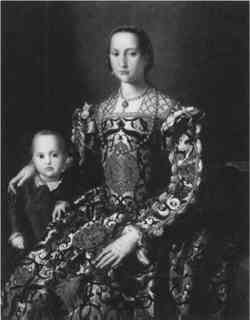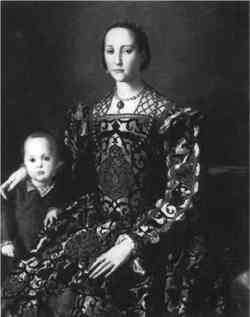EVIDENCE OF REPLICATION IN A PORTRAIT OF ELEONORA OF TOLEDO BY AGNOLO BRONZINO AND WORKSHOPSERENA URRY
1 INTRODUCTIONPortrait of Eleonora of Toledo and Her Son(fig. 1) entered the collection of the Detroit Institute of Arts in 1942 after having been there on loan since 1923. Its provenance extends only to the mid-19th century, when it appeared in Britain in the Hamilton Collection. Its conservation records list minor treatment for flaking in 1930, revarnishing in 1948, cleaning in 1955, and treatment for additional flaking in 1974 and 1977. In 1994, serious local cleavage was observed in the portrait. It was removed from the gallery to the Conservation Services Laboratory for treatment.
The Detroit portrait is a copy of the Portrait of Eleonora of Toledo and Her Son by Agnolo Bronzino in the Uffizi Galleries (fig. 2). It had always been judged by scholars to be a replica, a copy of the original made by the artist. However, the degree to which it is autograph has been disputed. Some scholars believed it to be wholly by Bronzino (Berenson 1963) and others wholly a workshop piece (McComb 1928).
Visual and material analysis conducted on the occasion of the conservation treatment addressed the issue of autography. The evidence garnered during treatment was material, compositional, technical, and qualitative in nature. It variously addressed the hypotheses that support identification of the Detroit portrait as a replica. These hypotheses are (1) that the Detroit portrait is a contemporary copy of the Uffizi portrait; (2) that it was produced by a workshop; and (3) that it was painted at least in part by Bronzino. |

